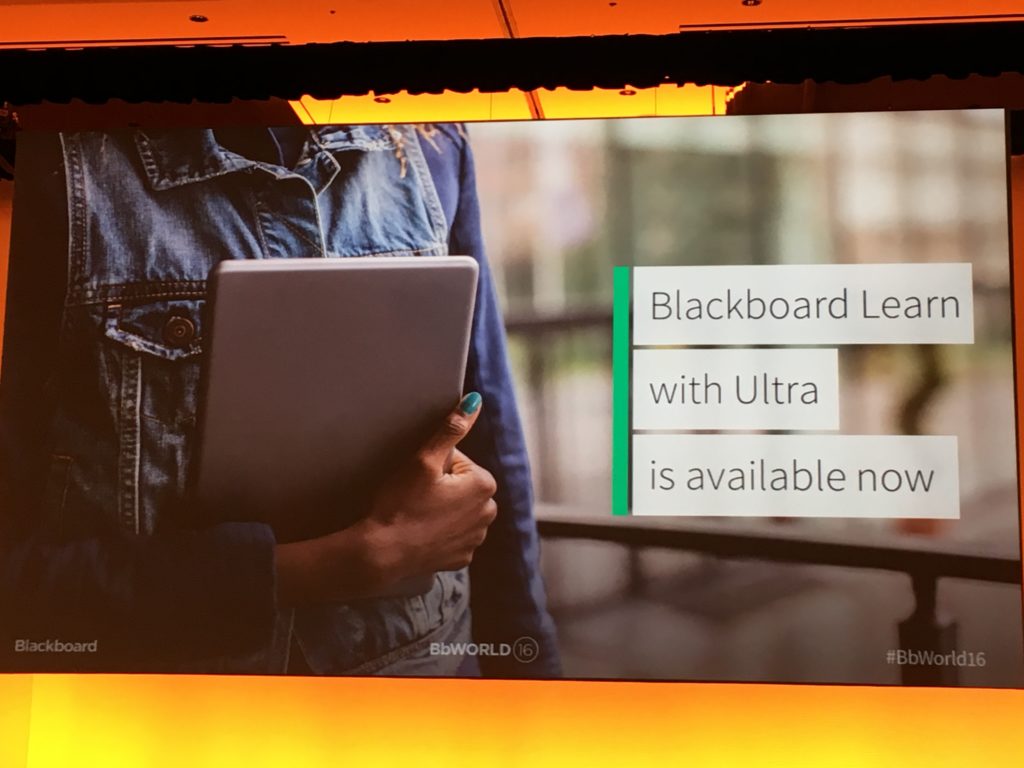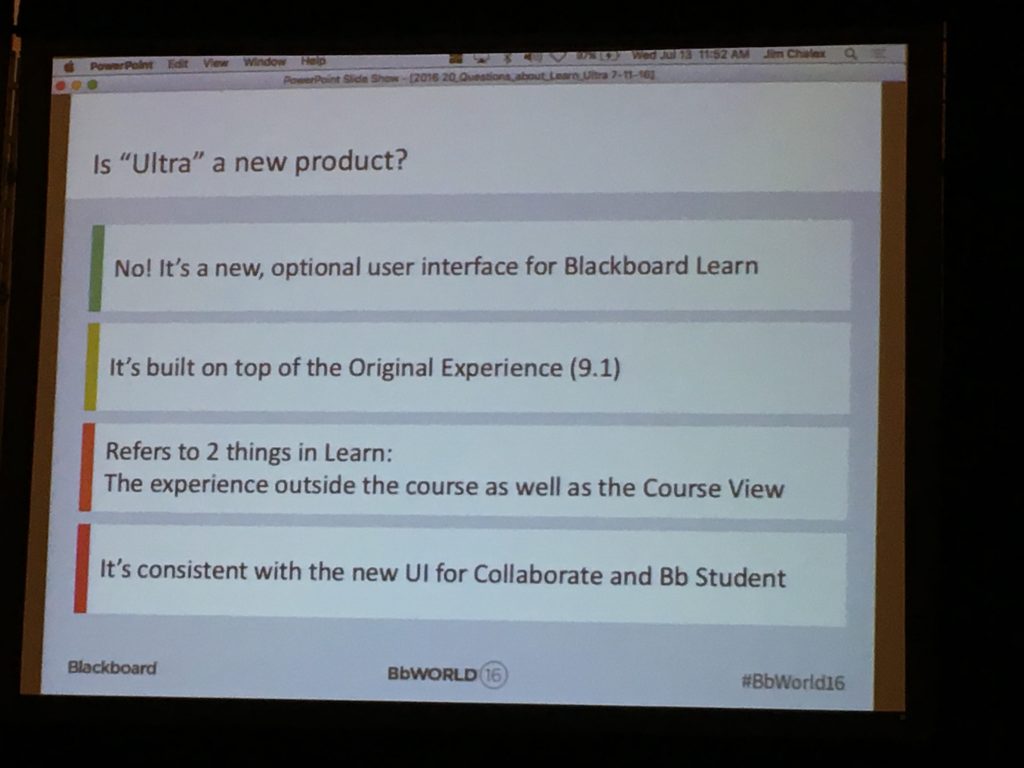At this year’s BbWorld16 users conference, Blackboard’s new executive team demonstrated their ability to deliver a much tighter, more coherent message of what they are learning from talking to customers and what the focus of the company will be in the next few years. The “1 Learn, 2 Experiences (Original and Ultra), and 3 Deployments (Self-Hosted, Managed-Hosted, and SaaS)” meme is an example. Words are easy to come by, however, and Blackboard leadership needs to back up their claims, particularly with the Learn LMS and particularly with the long-delayed Learn Ultra.
Michael described the challenges that Blackboard and its new CEO Bill Ballhaus face back in January, with this comment about Learn Ultra [emphasis added]:
Prove that Ultra is real: While there are customers who will not be quick to move off of 9.x (for a variety of reasons), nobody believes that the current platform represents a compelling future for digital learning environments. It is long in the tooth. But schools evaluating LMSs have largely discounted Ultra because they don’t think it’s real and they’re not convinced that it ever will be. Now that the product is a year late, they have increased reason to be skeptical. We have heard that there are schools piloting Ultra, but I am not aware of any public information about how these pilots are going or even which schools are participating. Blackboard needs to ship Ultra and trot out some customers who are willing to speak publicly about their experiences with it. If they fail, they will not get a do-over.
While this inaccurate claim came from the previous executive team, and while I have heard nothing but positive reviews from Blackboard staff about the new CEO, this does not mean that previous claims are irrelevant. And the issue is not what Blackboard told us at e-Literate, it is more what they have told or not told the higher education (and K-12) communities.
Thanks to an interview Michael and I had in April with Bill Ballhaus and Katie Blot, SVP of Corporate Strategy and Industry Relations, I updated our understanding of Learn Ultra’s status:
When we asked when Learn Ultra would be available for schools to actively pilot (real courses, real students, with major integrations to student rosters, etc), it was interesting to hear both Ballhaus and Blot take a very different approach and give what appears to be much more conservative estimates. Learn Ultra should be available for limited-functionality pilots for specific faculty (e.g. for courses not using the LMS heavily) by Fall 2016 and more broadly for institutions in Spring 2017, leading to general availability in Summer or Fall 2017.
This is why I was surprised to see a press release just this week claiming that “Blackboard Learn Ultra Experience Available Now”. At the keynote, Bill Ballhaus said that Learn Ultra was “generally available”, although based on another interview with Ballhaus and Blot later in the week it became apparent that this was inadvertent phrase. The real message is that Learn Ultra is ready for production as described in Katie Blot’s blog post:
Bill told the crowd (40% of whom are attending their first BbWorld) that the highly anticipated Blackboard Learn Ultra experience is now available for production use.

Did Blackboard just pull a rabbit out of the hat since April and move its general availability of Learn Ultra from Summer 2017 to Summer 2016? Based on interviews and in breakout sessions this week, the simple fact is that Learn Ultra is just now entering the phase for running pilots. While IT language can be fuzzy, a pilot is generally understood to be a test for a subset of the target end users, typically running on the final or production environment, using real-world scenarios, for the purposes of testing the system and determining if the application is ready to go into full production mode. For a higher education LMS, this means at a minimum running multiple courses within an institution with real students taking the courses for at least a full academic term. The very first Learn Ultra pilots in higher education are starting this fall at the University of Phoenix and “a handful” of other institutions.
Last night Katie Blot shared a link to a new blog post from the company – “Where we stand with SaaS and the Ultra experience”.
- And, delivered via continuous updates the Learn Ultra functionality that will meet the needs of many instructors. In fact, at BbWorld 2016 we declared that Learn with the Ultra experience is available now for pilot and production use.
So let’s clarify what we mean when we say that Learn with Ultra experience is available now. Learn with the Ultra experience now has a rich enough feature set to meet the needs of a certain segment of instructors. It’s ready for those who use the fundamental elements of an LMS. Will it be right for everyone? No, but the Original Course View, which can be run side by side with the Ultra Course View in SaaS, will meet the needs of the rest of instructors, those who need the full depth and flexibility the Original experience provides. And over time, we’ll continue to deliver more functionality for the Ultra experience on a frequent and regular basis, just like we have with Collaborate and Bb Student.
This blog post is a good sign of trying to be open and transparent, and the clarification about pilots is important. I still find the language “available for … production use” to be inaccurate. No academic leader in their right mind would skip a controlled pilot testing out this long-awaited LMS re-architecture and go straight into full production mode. And to my knowledge no institution has indicated that they plan to do so.
The message I heard over and over from people who had tried the Learn Ultra “educator preview” matched what SUNY’s Doug Cohen shared in his session where Blackboard asked him to try out Learn Ultra and present his findings unfiltered. There are some nice design features in Ultra, and there have been vast improvements in functionality – both bug fixes and new features – added within the past four months. But as Doug shared, Learn Ultra is not ready to evaluate yet at an institutional level. While he noted in a conversation after the session that this would be an individual campus decision within SUNY and not up to the system office where he works, in Doug’s opinion Learn Ultra will likely be ready for a true test by the beginning of 2017. There are a handful of schools, most notably the University of Phoenix, that are being more aggressive and starting pilots this fall, but I am hearing a consensus that Learn Ultra needs more time before having institutional-run pilots.
The Blackboard team noted in their press release:
Based on user data, the product offers the functionality most instructors need to manage their courses today
The basis of this determination, according to Katie Blot, was driven by analyses such as looking at the courses in a large community college to see which components of Learn 9.1 were used in each course, and then determining if Learn Ultra had those features.1 There is a real difference, however, between analyzing such course data and asking real people responsible for making campus decisions of whether they would start a Learn Ultra pilot. If the vast majority of customers say that “it’s not ready to evaluate fully”, that does not necessarily mean that they must be waiting for Learn Ultra to have all features present in Learn 9.1 Original View to satisfy all faculty. Most campus administrators I have talked to know that Learn Ultra can be a course-by-course decision after you enable Ultra at the institutional level. The question is whether an institution is ready to enable this course-by-course testing and to support the new capabilities.
One more detail that is relevant to messaging. Once a course is converted to Learn Ultra, it cannot be converted back to Original view of Learn 9.1. You can go back to a snapshot of the course as of the time of conversion, but any course data created or added within Ultra will be lost. In other words Learn Ultra is much more than just an option user interface sitting on top of Learn 9.1, as described in one of the breakout sessions.

If Blackboard executives want to be open and transparent, which I believe they do, then part of the job is using straightforward, accurate language. Don’t play verbal gymnastics in “ready for production” without letting people know this will be the first time anyone has run live courses with real students. Don’t ignore the company baggage where customers and analysts have been told misleading stories even within the past year.
What Blackboard could have done is used this simple message to their advantage. We told you in April that we would be ready for limited-functionality pilots in fall, and we’re on schedule and making real improvements. The days of Learn Ultra delays are over.
The company has made a lot of progress in the past four months with Ultra, has improved the overall message, and has introduced some useful tools coming out such as Predict and Planner. But the community needs more in terms of open and transparent communication, especially around Learn.
- I believe they did this analysis from more than one school, but she mentioned this example to point out that they looked across the entire college, at all courses. [↩]
What is the replacement for renderinghook in blackboard Ultra